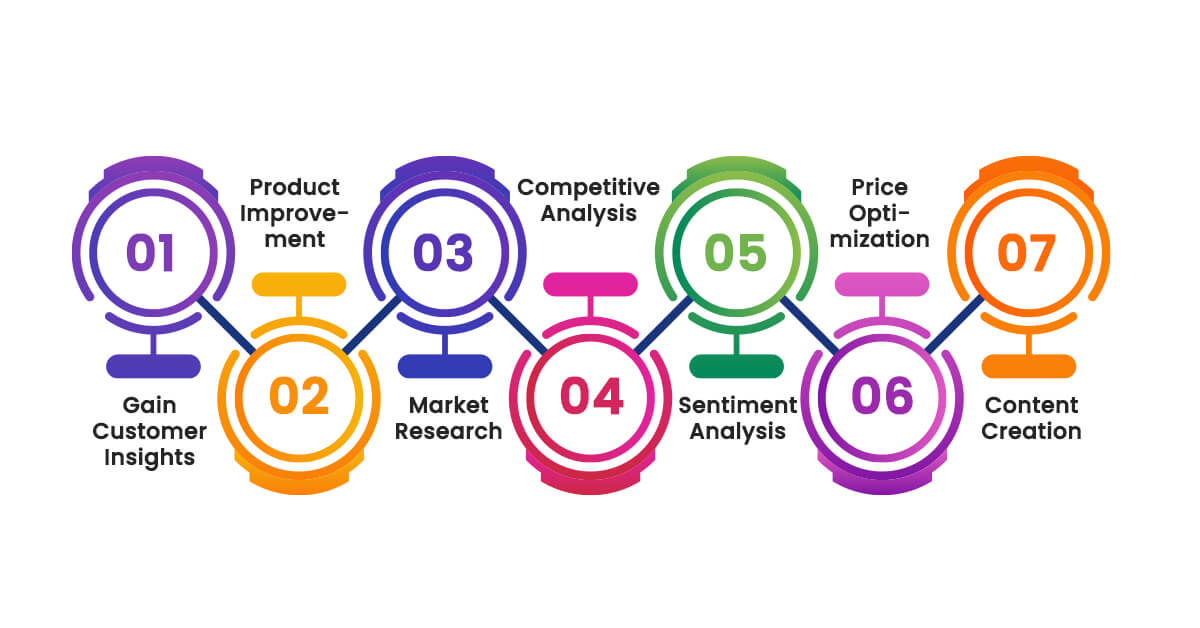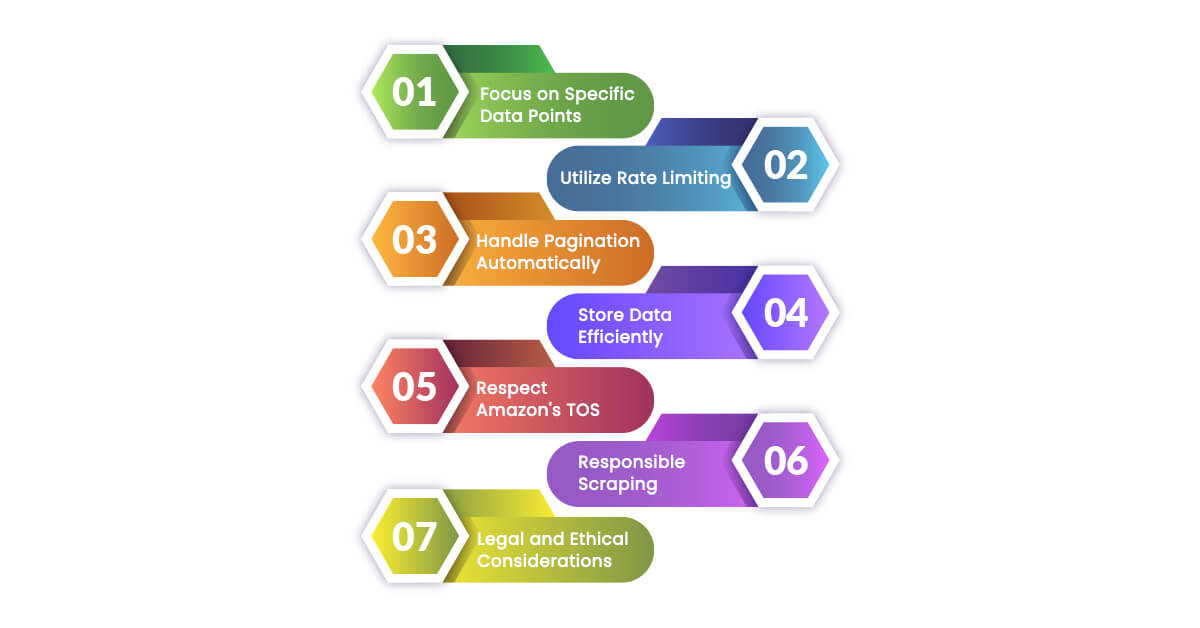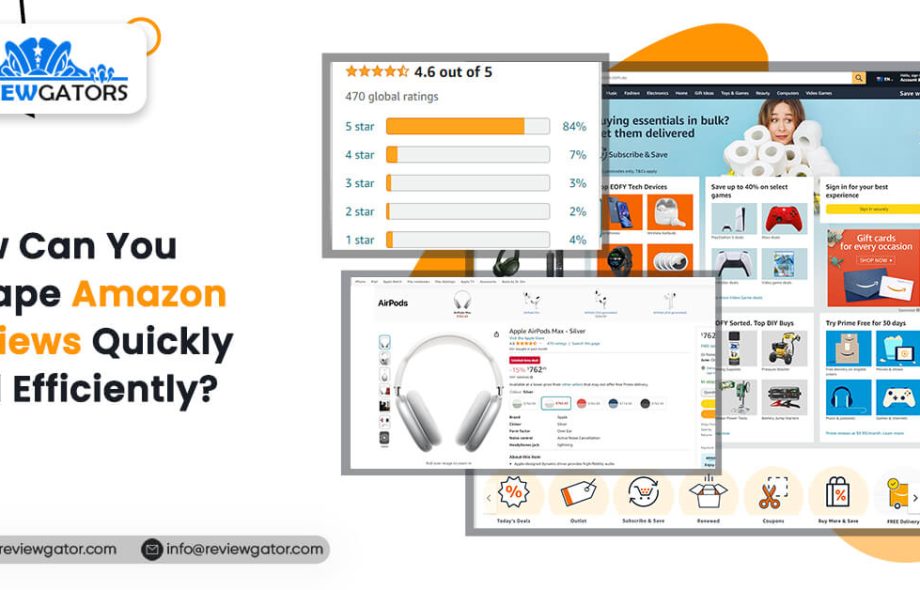Struggling to gather valuable customer insights from Amazon reviews? Are you tired of manually copying and pasting reviews one by one?
But what if there was a faster, more innovative way? This blog will guide you through the best practices for scraping Amazon reviews. This will help you unlock a treasure of data, providing you with the potential to improve product quality, refine marketing strategies, and stay ahead of the competition.
What is Amazon Review Scraping?
Amazon customer review scraping automatically extracts customer reviews and their details from Amazon product pages.
Review text
What customers say about the product, both positive and negative.
Ratings
The star rating assigned by the reviewer
Reviewer details
Username, location (if provided), and potentially even purchase history (depending on scraping method).
Date of review
When the review was posted.
Benefits of Scraping Amazon Reviews

Scraping Amazon customer reviews can be a powerful tool for businesses and researchers alike. Here are seven key benefits:
Gain Customer Insights
Reviews are full of true customer stories. By scraping them, you can quickly review a lot of information to determine how customers feel, spot frequent issues, and determine which features they like.
Product Improvement
Find out how to improve your or your competitors’ products. Look for what customers often like or don’t like to help you decide what to do next with your products and how to advertise them.
Market Research
Find out what’s currently popular and which products people like in a specific area. By looking at what people say in reviews, you can determine what they want and use this knowledge to decide which products to sell or what moves to make in your business.
Competitive Analysis
See how your products stack up against others. Check out what people say about your competitors to know what they’re good at and where they fall short. This can help you find ways to do better than them.
Sentiment Analysis
Look beyond just the number of stars a product gets. By scraping, you can study how customers feel as they write reviews, determining if their thoughts on a product are happy, unhappy, or somewhere in between.
Price Optimization
Look at how the price affects what customers think. Check if reviews get better or worse with different prices to help you decide how much to charge and stay competitive.
Content Creation
Reviews are great for brainstorming marketing ideas. You can quote positive reviews to write attractive product details or customer praise for your website.
How to Scrape Amazon Reviews?
Here’s a general overview of how amazon review scraper works:
Choose Your Tools:
There are two main approaches to scraping Amazon reviews:
- Web Scraping Libraries Libraries like Beautiful Soup (Python) or Cheerio (JavaScript) allow you to parse HTML content from websites. You can write scripts to extract review data based on specific HTML elements.
- Pre-built Scraping Tools Several online tools offer scraping functionalities for Amazon reviews. These tools often have user-friendly interfaces and may require minimal coding knowledge.
Identify Review Elements
Inspect the HTML structure of an Amazon product page to identify the elements containing review data. This typically includes sections with review text, star ratings, reviewer names (if available), and dates.
Extract the Data
- Using Libraries With libraries like Beautiful Soup, you can write code to navigate the HTML structure and extract the desired data points using selectors like CSS selectors or XPath.
Pre-built ToolsThese tools often have built-in functionalities to target specific elements and extract the relevant review data.
Handle pagination
If there are multiple review pages, you’ll need to handle pagination to scrape all of them. This might involve finding URLs for subsequent review pages or using features within your amazon review scraper to navigate them automatically.
Store the Data
The scraped data can be stored in various formats like CSV (comma-separated values) or JSON (JavaScript Object Notation) for further analysis or use in other applications.
Methods to Scrape Amazon Reviews Quickly and Effectively
Here are some methods to scrape Amazon reviews quickly and effectively, categorized by their technical complexity:
Pre-built Scraping Tools (Low Technical Knowledge):
- Web Scraping Platforms Several online platforms like Reviewgators or Scrapy offer pre-built tools specifically designed for scraping Amazon reviews. These tools are easy to use and don’t require much coding skills. You just set up the product link and pick what details you want to gather.
- Browser ExtensionsCertain browser extensions offer scraping functionalities for Amazon reviews. These extensions might be a good starting point for simple scraping tasks, but they may need to be improved, and data extraction capabilities may be limitations.
Programming Libraries (Medium Technical Knowledge):
- Python Libraries Libraries like Beautiful Soup or Scrapy (Python) allow you to write scripts to parse the HTML content of Amazon product pages. You can leverage these libraries to target specific review data elements using selectors like CSS or XPath. This method offers more control and customization than pre-built tools but requires some programming knowledge.
- JavaScript LibrariesLibraries like Cheerio (JavaScript) offer similar functionalities to Python libraries, allowing you to scrape Amazon reviews within a JavaScript environment. This approach might be suitable if you’re already working with JavaScript for other purposes.
Web Scraping APIs (Medium to High Technical Knowledge):
- Web Scraping APIs Services like Crawlbase or ParseHub offer APIs that allow you to access scraped data from Amazon reviews programmatically. These review scraper APIs handle the complexities of web scraping, like managing user-agent headers, rotating IP addresses, and respecting robots.txt files. This method requires coding knowledge to integrate the amazon review scraper API into your application but offers a robust and scalable solution.
Tips for Faster and More Effective Scraping

By choosing the best practices and following these tips, you can scrape Amazon reviews quickly and effectively, gaining valuable insights for your research or business needs.
Focus on Specific Data Points
Identify the exact review elements you need (text, rating, date) and tailor your scraping process accordingly.
Utilize Rate Limiting
Implement delays between scraping requests to avoid overwhelming Amazon’s servers and potential IP blocking.
Handle Pagination Automatically
Use libraries or tools that can automatically navigate through multiple review pages.
Store Data Efficiently
Choose appropriate data formats (CSV, JSON) and consider cloud storage solutions for large datasets.
Respect Amazon’s TOS
Always prioritize ethical scraping practices and comply with Amazon’s Terms of Service (TOS) and the robots.txt file.
Responsible Scraping
Avoid overloading Amazon’s servers and scrape only what you need. Consider using proxy services to rotate your IP address if necessary.
Legal and Ethical Considerations
Research scraping regulations and ensure your use case complies with ethical practices.
Conclusion
Using these scraping methods, you can change how you do research, get important information quickly, and get ahead in your market. It’s important to scrape the right way, follow Amazon’s ToS, and prioritize ethical practices.
Companies like Reviewsgator provide strong scraping tools and help for businesses big and small that want an easier way. They can deal with the hard parts, so you can use customer reviews to improve your business!
Know More:https://www.reviewgators.com/scrape-amazon-reviews-quickly-and-efficiently.php
 :
https://www.reviewgators.com
:
https://www.reviewgators.com












